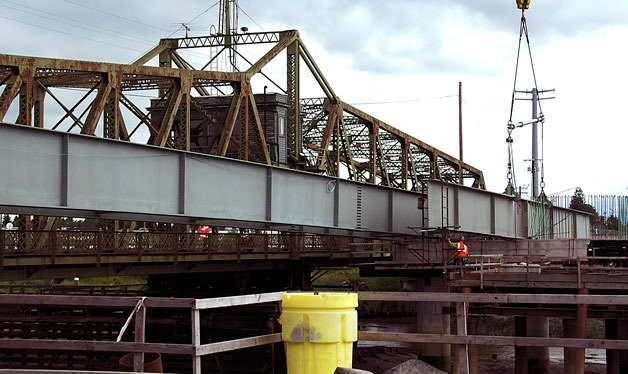MARYSVILLE — The ongoing project to replace the aging State Route 529 Bridge over Ebey Slough is approaching a milestone moment, as construction crews expect to finish setting the girders that will form the backbone of the wider, taller new bridge this month.
Washington State Department of Transportation Project Engineer Janice Fahning explained that Granite Construction began setting the seven girders — each of which is seven feet tall and weighs an average of 31 tons, and whose individual lengths range from 100-135 feet each — at the start of June. She noted that crews are assembling the girders from 49 total pieces, and anticipated that the final pieces would be installed by the end of the month.
“Building the bridge deck on top of these girders will be our next major step before we can start opening the new bridge lanes,” said Fahning, who anticipated that northbound traffic would be shifted from the current State Route 529 bridge to the new bridge by April of 2012, with all traffic on the new bridge by August of that same year. “As the project continues, we should only occasionally need to close lanes to complete our work.”
According to Fahning, this project has employed 19 subcontractors, 23 material suppliers and 150 individuals, with an average of 24 workers on site during a given day. The 680-foot-long, four-lane fixed span bridge has also required two cranes in order to install certain segments of its girders. After all traffic is finally shifted over to the new bridge, the 86-year-old existing bridge will be demolished, wrapping up the $42.3 million project with a target date at the end of 2013.
WSDOT Chief Inspector Joe Rooney presented the decision to use steel girders, instead of the more popular fabricated concrete, as a way to save time, money and the environment.
“Usually, fabricated concrete is quicker and cheaper,” Rooney said. “But steel is not only stronger, but also lighter, which meant we needed less structural support to install it. More structures would have taken longer, cost more and incurred additional environmental impacts.”
Rooney agreed with Fahning that there should be no need for full closures to shift traffic or continue construction work. He touted the new bridge’s elevated clearance for boat traffic, as well as its two 12-foot-wide lanes, separate five-foot-wide bicycle lanes and six-foot-wide sidewalks each in both the northbound and southbound directions, which he compared to the current bridge’s single 11-foot-wide lane in each direction.
“This project is on schedule and under budget, with no major issues,” Rooney said. “We’ve had great working relationships with our crews. This will be a huge benefit to the roughly 17,000 drivers that commute between Marysville and Everett every day.”



